A Wide Dynamic Range CMOS Image Sensor with a Charge Splitting Gate and Two Storage Diodes
Abstract
1. Introduction
2. Operation Principle of the Wide Dynamic Range Pixel
3. Pixel Design
4. Implementation and Experimental Results
5. Discussions
6. Conclusions
Author Contributions
Funding
Acknowledgments
Conflicts of Interest
References
- Das, D.; Collins, S. Fixed-Pattern-Noise Correction for an Integrating Wide-Dynamic-Range CMOS Image Sensor. IEEE Trans. Electron Devices 2013, 60, 314–319. [Google Scholar] [CrossRef]
- Belenky, A.; Fish, A.; Spivak, A.; Yadid-Pecht, O. Global Shutter CMOS Image Sensor with Wide Dynamic Range. IEEE Trans. Circuits Syst. 2007, 54, 1032–1036. [Google Scholar] [CrossRef]
- Spivak, A.; Belenky, A.; Fish, A.; Yadid-Pecht, O. A Wide-Dynamic-Range CMOS Image Sensor with Gating for Night Vision System. IEEE Trans. Circuits Syst. 2011, 58, 85–89. [Google Scholar] [CrossRef]
- Lee, J.; Baek, I.; Yang, K. Memoryless Wide-Dynamic-Range CMOS Image Sensor Using Nonfully Depleted PPD-Storage Dual Capture. IEEE Trans. Circuits Syst. 2013, 60, 26–30. [Google Scholar] [CrossRef]
- Kim, D.; Chae, Y.; Cho, J.; Han, G. A Dual-Capture Wide Dynamic Range CMOS Image Sensor Using Floating-Diffusion Capacitor. IEEE Trans. Electron Devices 2008, 55, 2590–2594. [Google Scholar]
- Sasaki, M.; Mase, M.; Kawahito, S.; Tadokoro, Y. A wide-dynamic-range CMOS image sensor based on multiple short exposure-time readout with multiple-resolution column-parallel ADC. IEEE Sens. J. 2007, 7, 151–158. [Google Scholar] [CrossRef]
- Lee, W.; Akahane, N.; Adachi, S.; Mizobuchi, K.; Sugawa, S. A 1.9e- Random Noise CMOS Image Sensor With Active Feedback Operation in Each Pixel. IEEE Trans. Electron Devices 2009, 56, 2436–2445. [Google Scholar] [CrossRef]
- Kawada, S.; Sakai, S.; Tashiro, Y.; Sugawa, S. Checked White-RGB Color LOFIC CMOS Image Sensor. In Proceedings of the 2010 Asia and South Pacific Design Automation Conference, Taipei, Taiwan, 18–21 January 2010. [Google Scholar]
- Sugo, H.; Wakashima, S.; Kuroda, R.; Yamashita, Y.; Sumi, H.; Wang, T.; Chou, P.; Hsu, M.; Sugawa, S. A Dead-time Free Global Shutter CMOS Image Sensor with in-pixel LOFIC and ADC using Pixel-wise Connection. In Proceedings of the 2016 IEEE Symposium on VLSI Circuits, Honolulu, HI, USA, 15–17 June 2016. [Google Scholar]
- Shafie, S.; Kawahito, S.; Itoh, S. A Dynamic Range Expansion Technique for CMOS Image Sensors with Dual Charge Storage in a Pixel and Multiple Sampling. Sensors 2008, 8, 1915–1926. [Google Scholar] [CrossRef] [PubMed]
- Shafie, S.; Kawahito, S.; Yoon, H.; Itoh, S. A Dynamic Range Expansion Technique Using Dual Charge Storage in a CMOS APS and Multiple Exposures for Reduced Motion Blur. Trans. ITE 2008, 62, 2037–2044. [Google Scholar] [CrossRef]
- Solhusvik, J.; Yaghmai, S.; Kimmels, A.; Stephansen, C.; Storm, A.; Olsson, J.; Rosnes, A.; Martinussen, T.; Willassen, T.; Pahr, P.O.; et al. A 1280 × 960 3.75 um pixel CMOS imager with Triple Exposure HDR. Available online: http://www.imagesensors.org/Past%20Workshops/2009%20Workshop/2009%20Papers/081_Solhusvik_HDR_DCG_final.pdf (accessed on 29 June 2019).
- Murata, M.; Kuroda, R.; Fujiwara, Y.; Aoyagi, Y.; Shiabata, H.; Shibaguchi, T.; Kamata, Y.; Miura, N.; Kuriyama, N.; Sugawa, S. A 24.3 Me- full well capacity CMOS image sensor with lateral overflow integration trench capacitor for high precision near infrared absorption imaging. In Proceedings of the 2018 IEEE International Electron Devices Meeting (IEDM), San Francisco, CA, USA, 1–5 December 2018. [Google Scholar]
- Teranishi, N.; Kohono, A.; Ishihara, Y.; Oda, E.; Arai, K. No image lag photodiode structure in the interline CCD image sensor. In Proceedings of the 1982 International Electron Devices Meeting, San Francisco, CA, USA, 13–15 December 1982. [Google Scholar]
- Lee, M.; Seo, M.-W.; Ueno, D.; Takasawa, T.; Shin, J.-K.; Yasutomi, K.; Kagawa, K.; Kawahito, S. A Wide Dynamic Range CMOS Image Sensor with Two Different Sensitivity Storage Diodes. IEEE J. Solid-State Cricuits. 2016, 40, 2787–2795. [Google Scholar]
- Yadid-Pecht, O.; Fossum, E. Wide Intrascene Dynamic Range CMOS APS Using Dual Sampling. IEEE Trans. Electron Devices 1997, 4, 1721–1722. [Google Scholar] [CrossRef]
- Mutoh, H. 3-D optical and electrical simulation for CMOS image sensors. IEEE Trans. Electron Devices 2003, 50, 19–25. [Google Scholar] [CrossRef]
- Seo, M.W.; Suh, S.; Iida, T.; Takasawa, T.; Isobe, K.; Watanabe, T.; Itoh, S.; Yasutomi, K.; Kawahito, S. A low-noise high intrascene dynamic range CMOS image sensor with a 13 to 19b variable-resolution column-parallel folding-integration/cyclic ADC. IEEE J. Solid-State Circuits 2012, 47, 272–283. [Google Scholar] [CrossRef]
- Mantiuk, R.; Myszkowski, K.; Seidel, H.P. High Dynamic Range Imaging, Wiley Online Library. Available online: https://doi.org/10.1002/047134608X.W8265 (accessed on 29 June 2019).
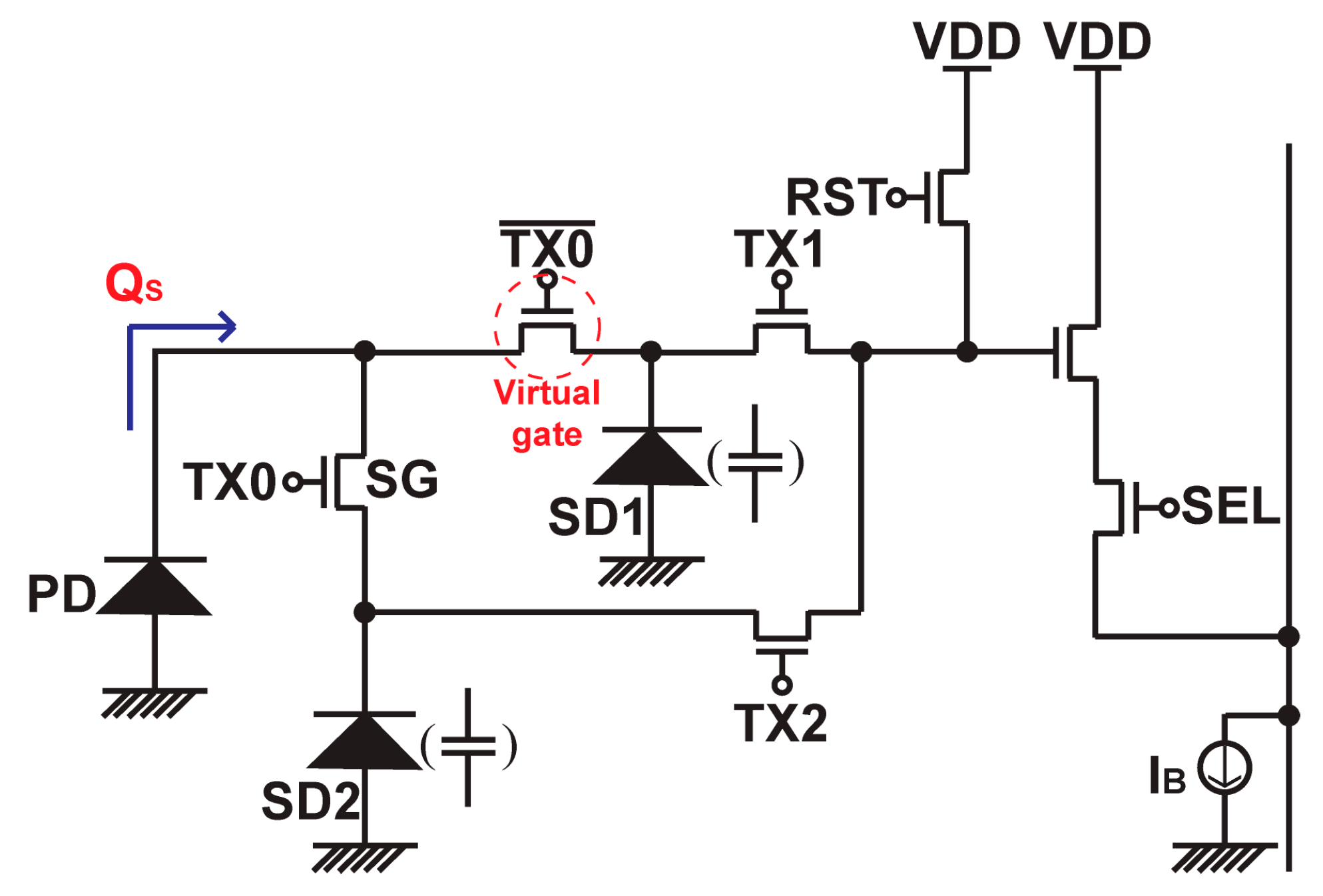

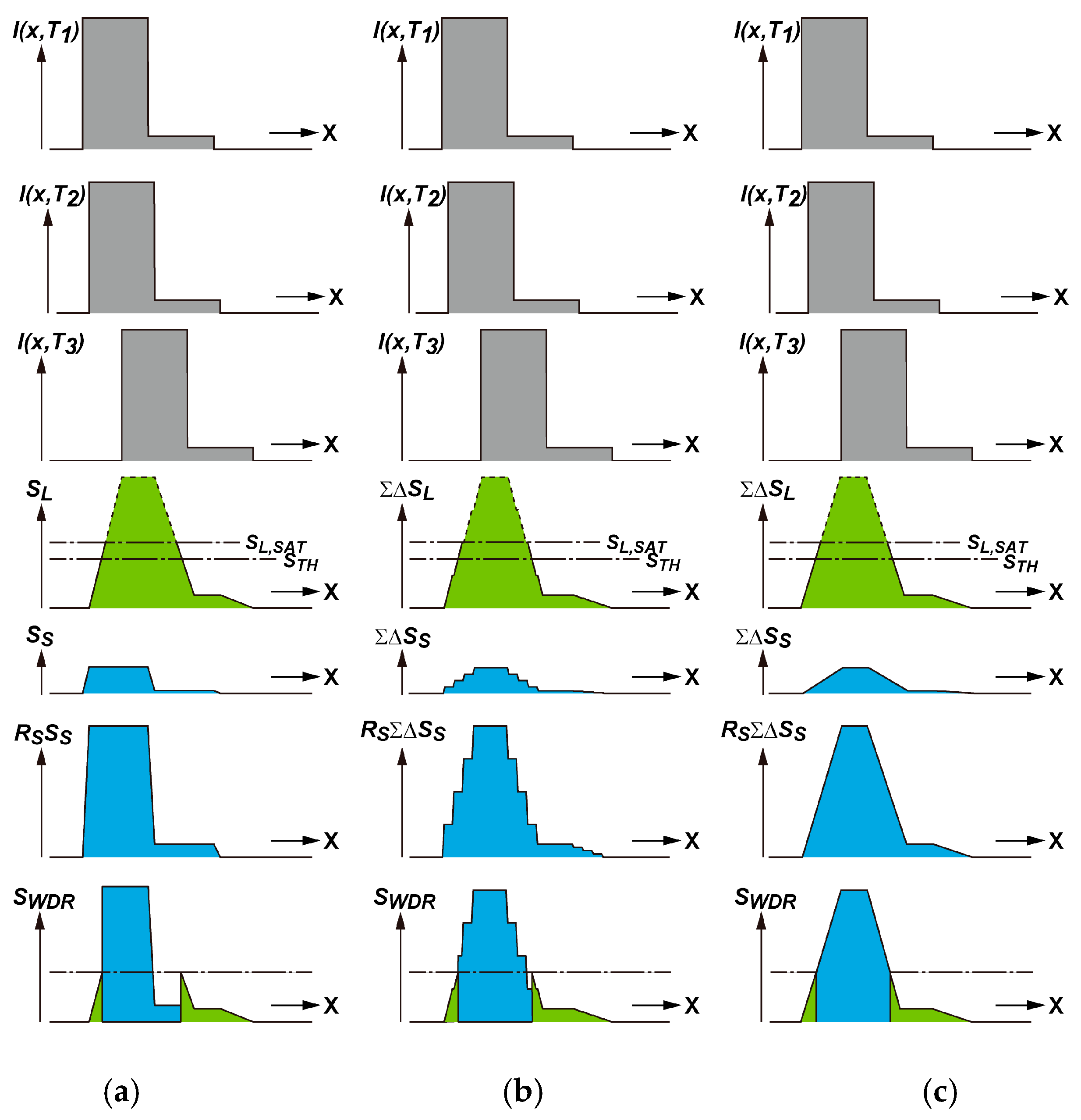
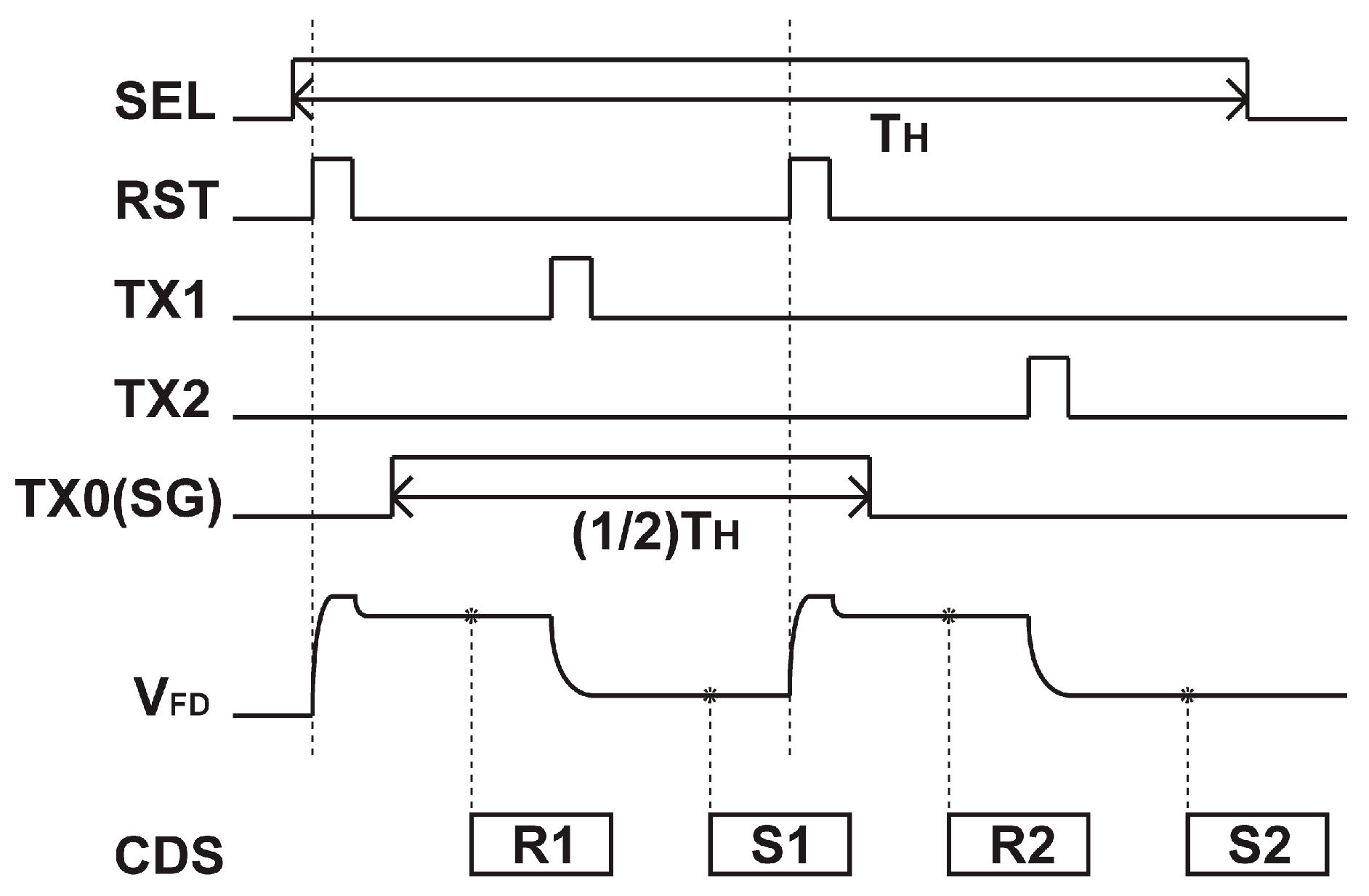
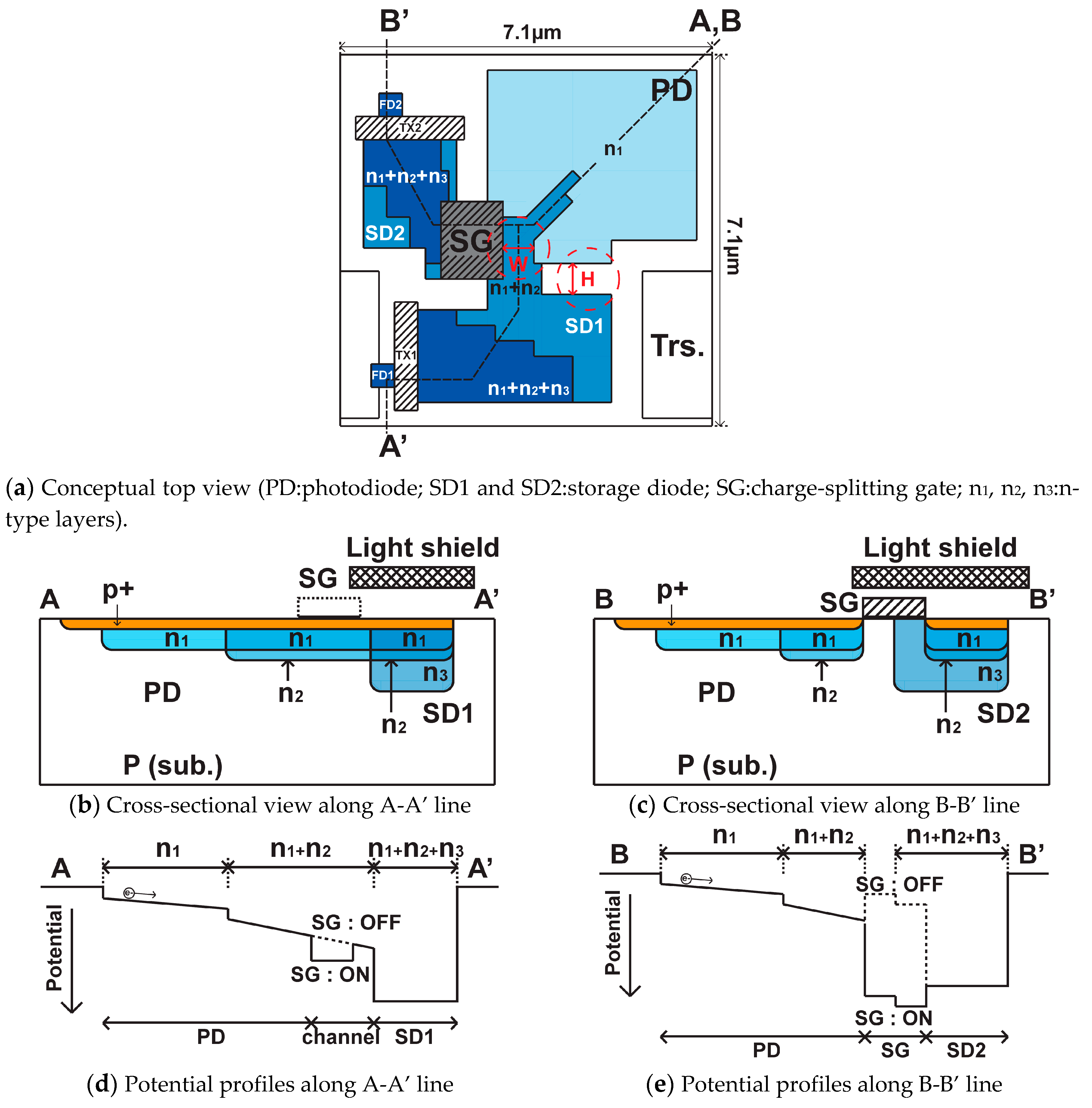
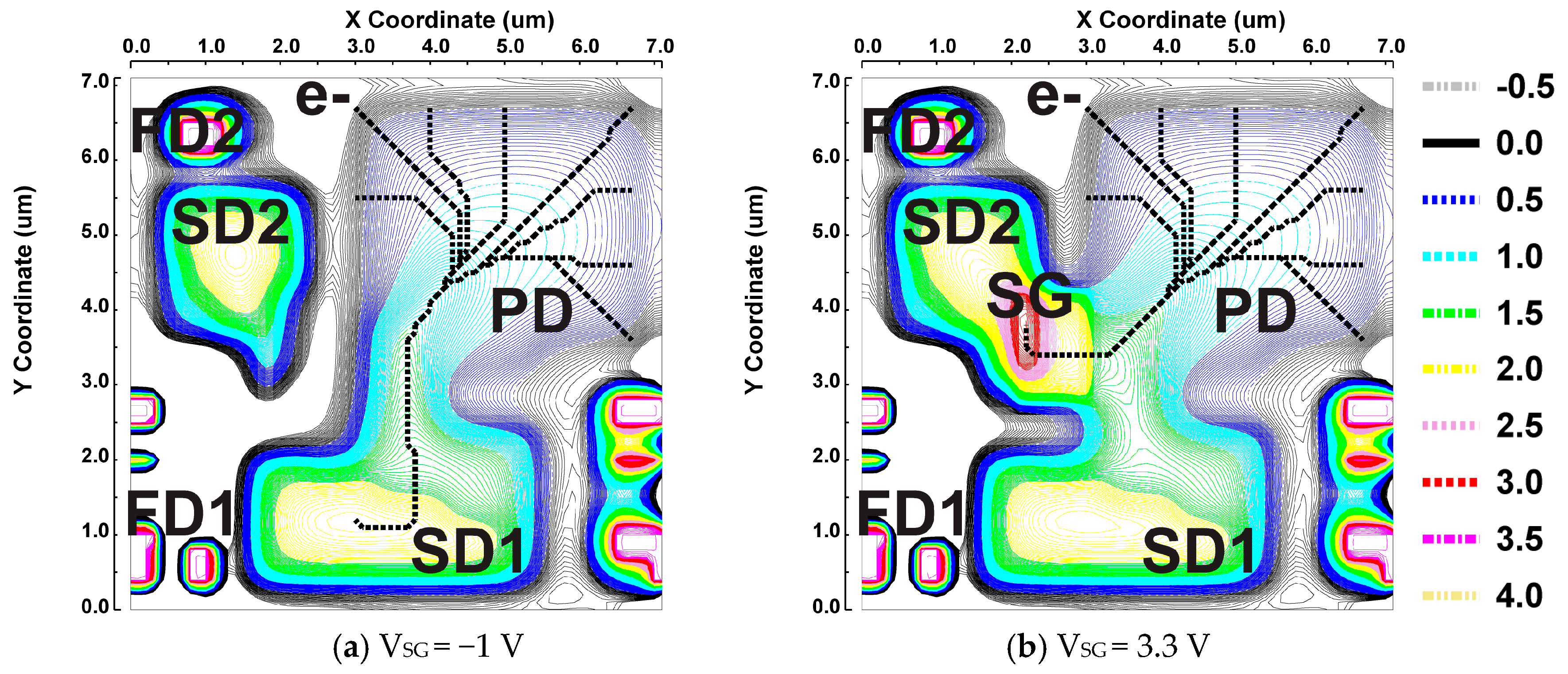

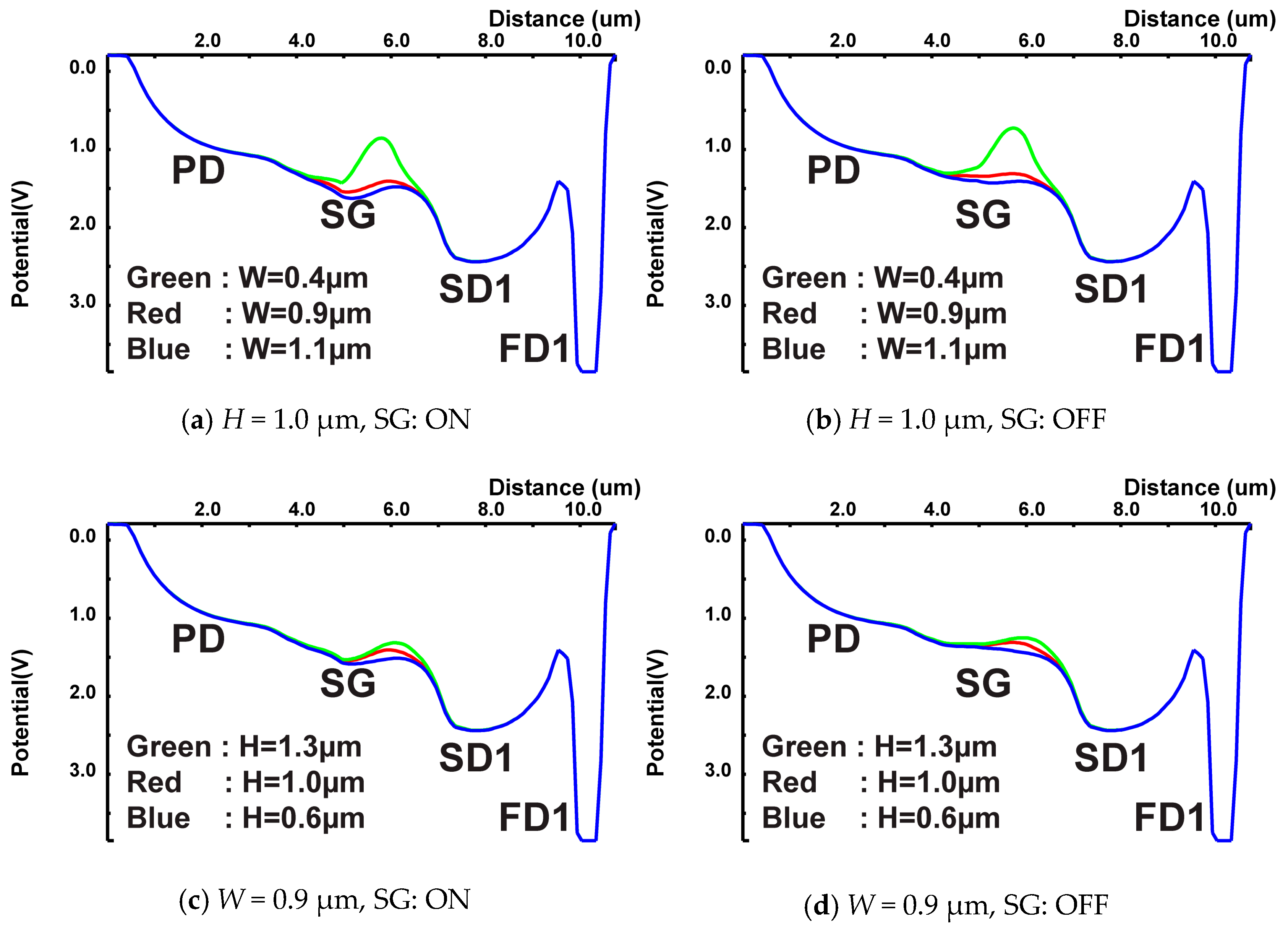
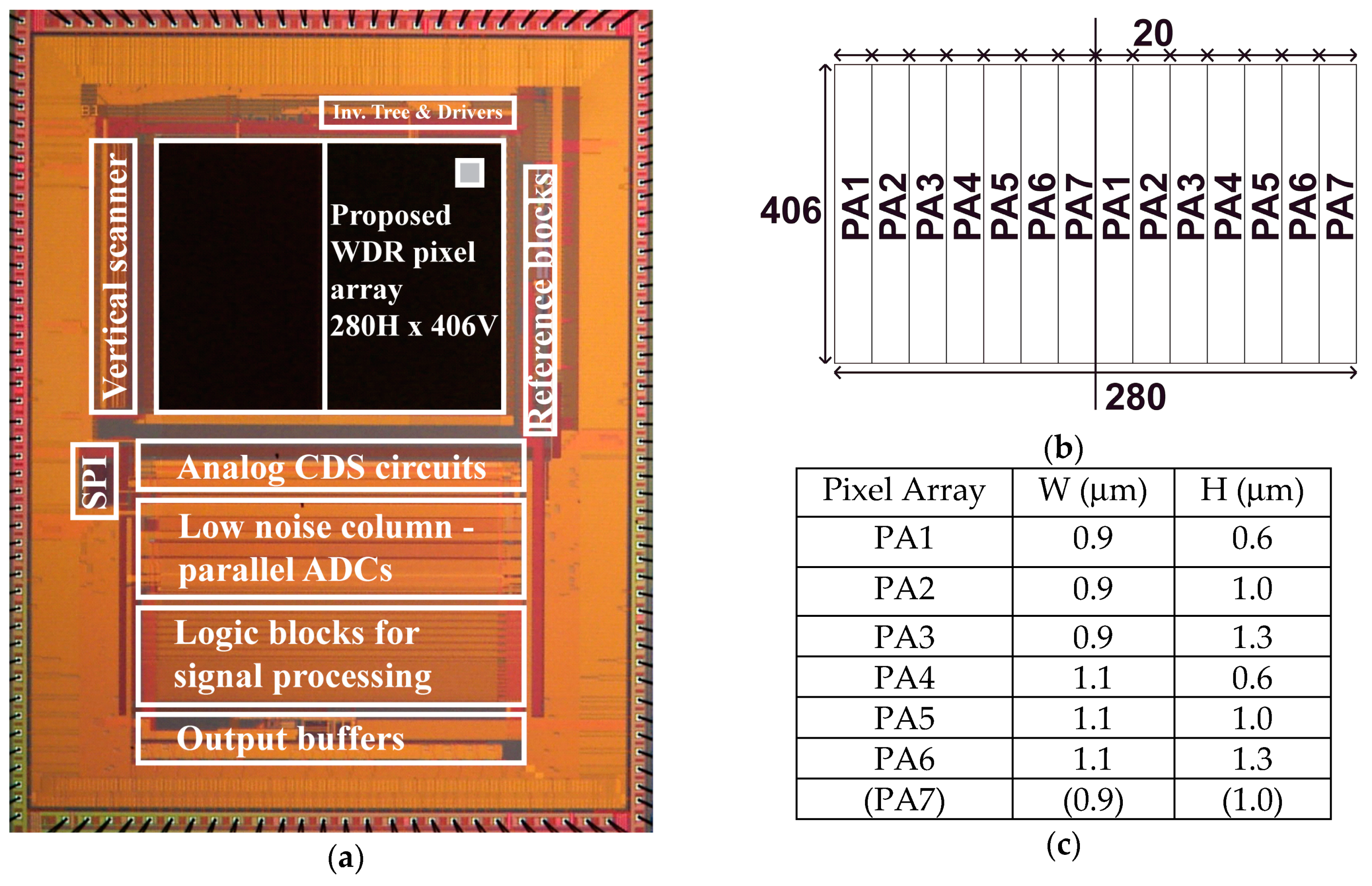
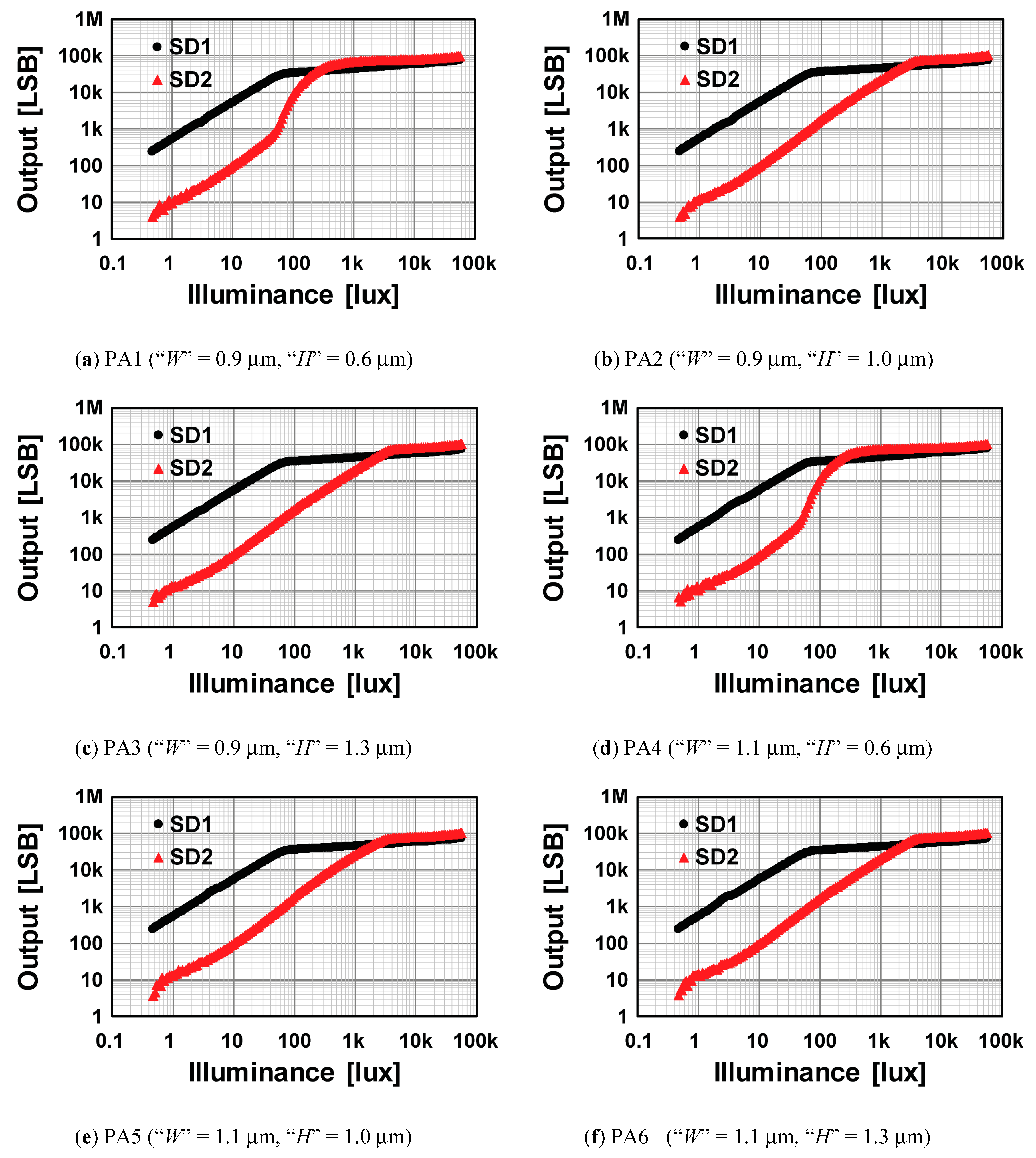
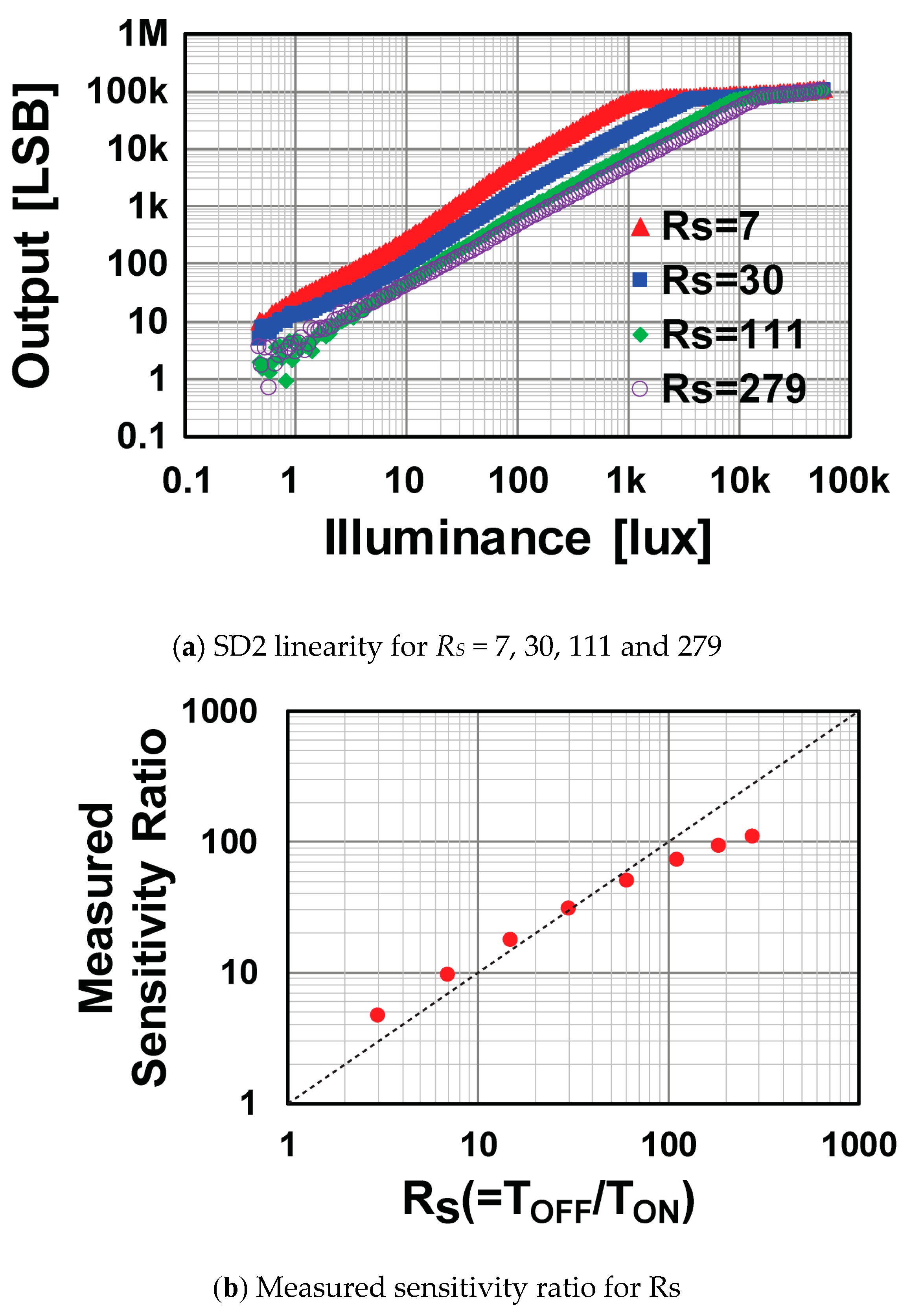
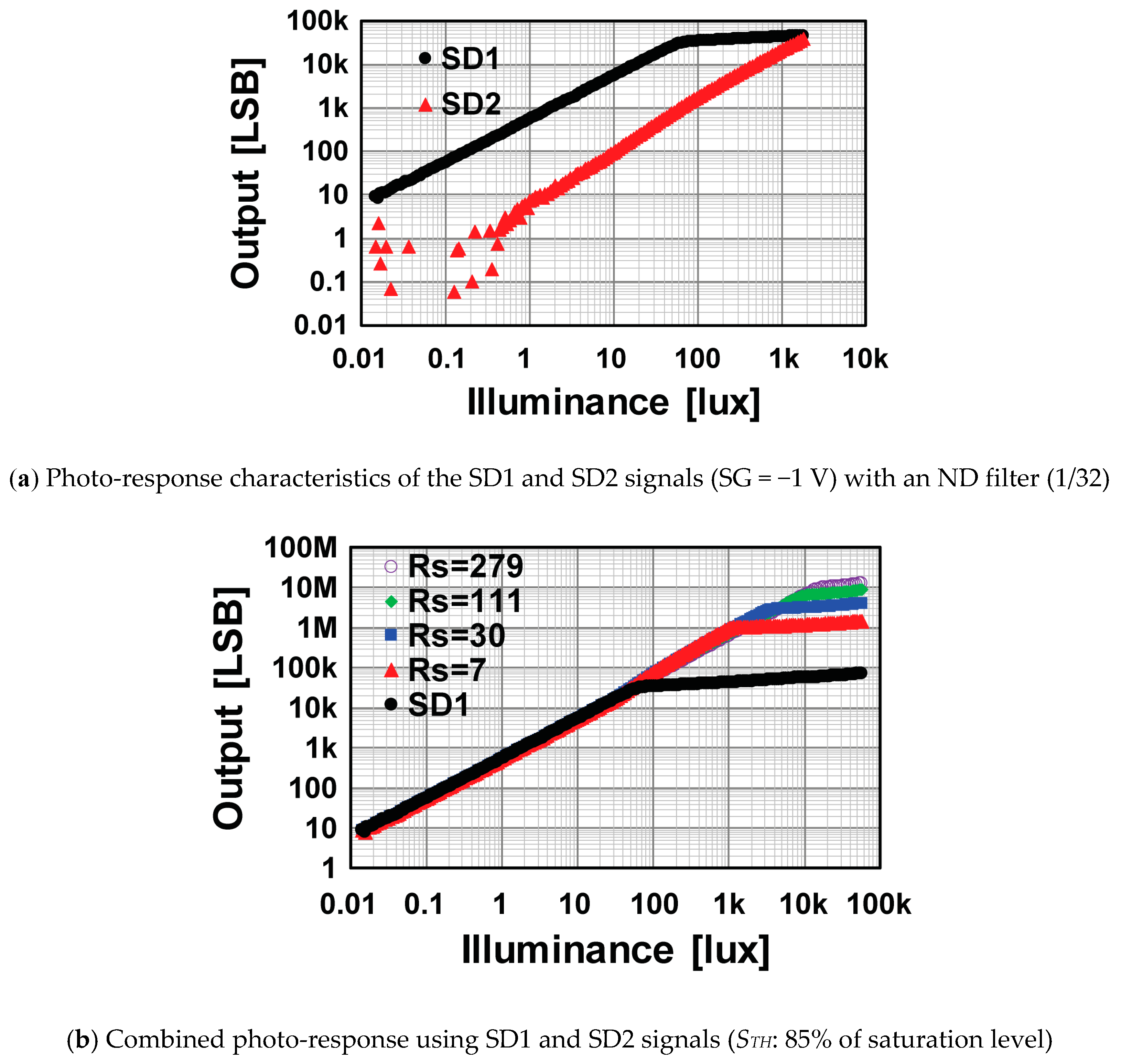
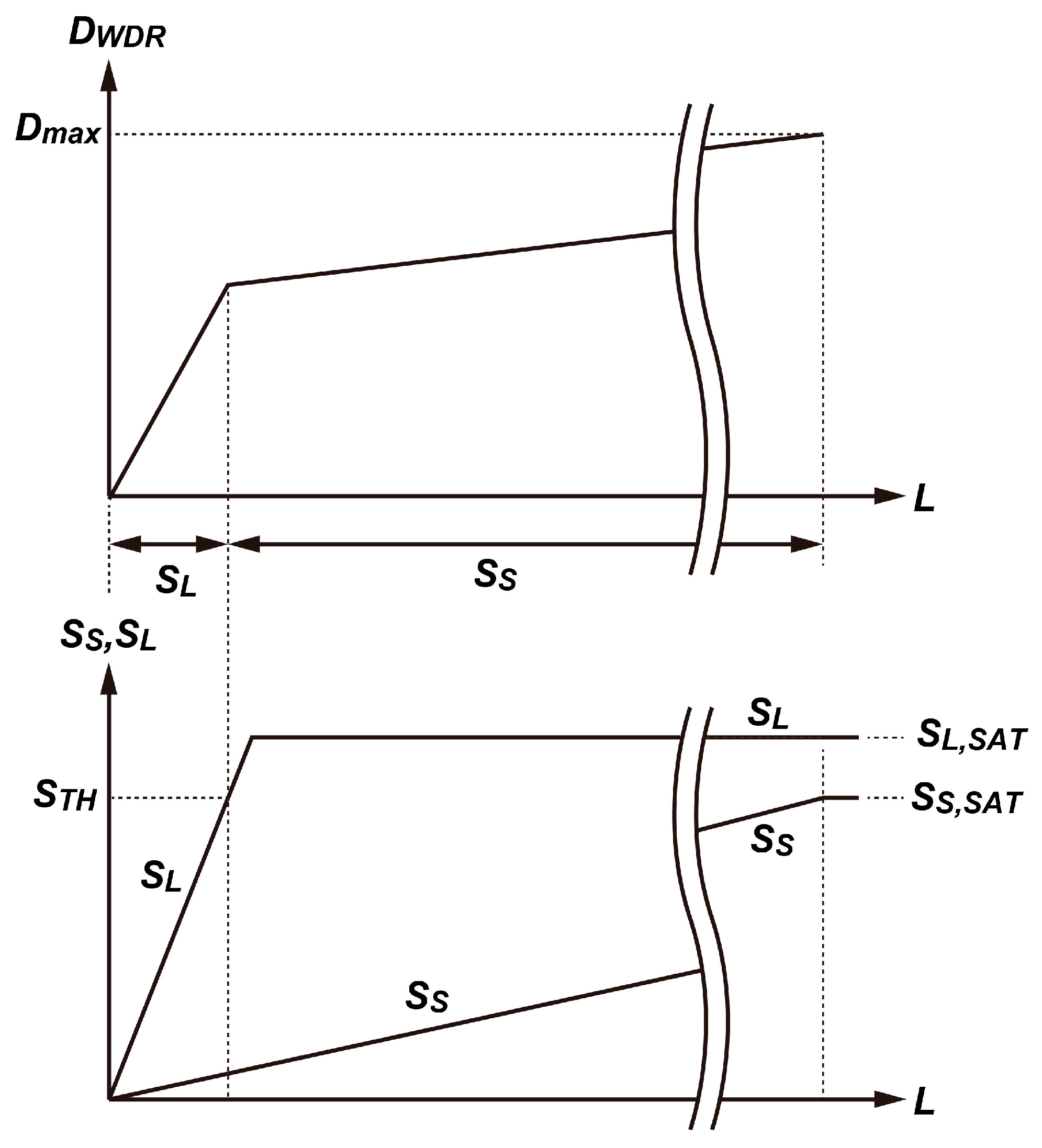
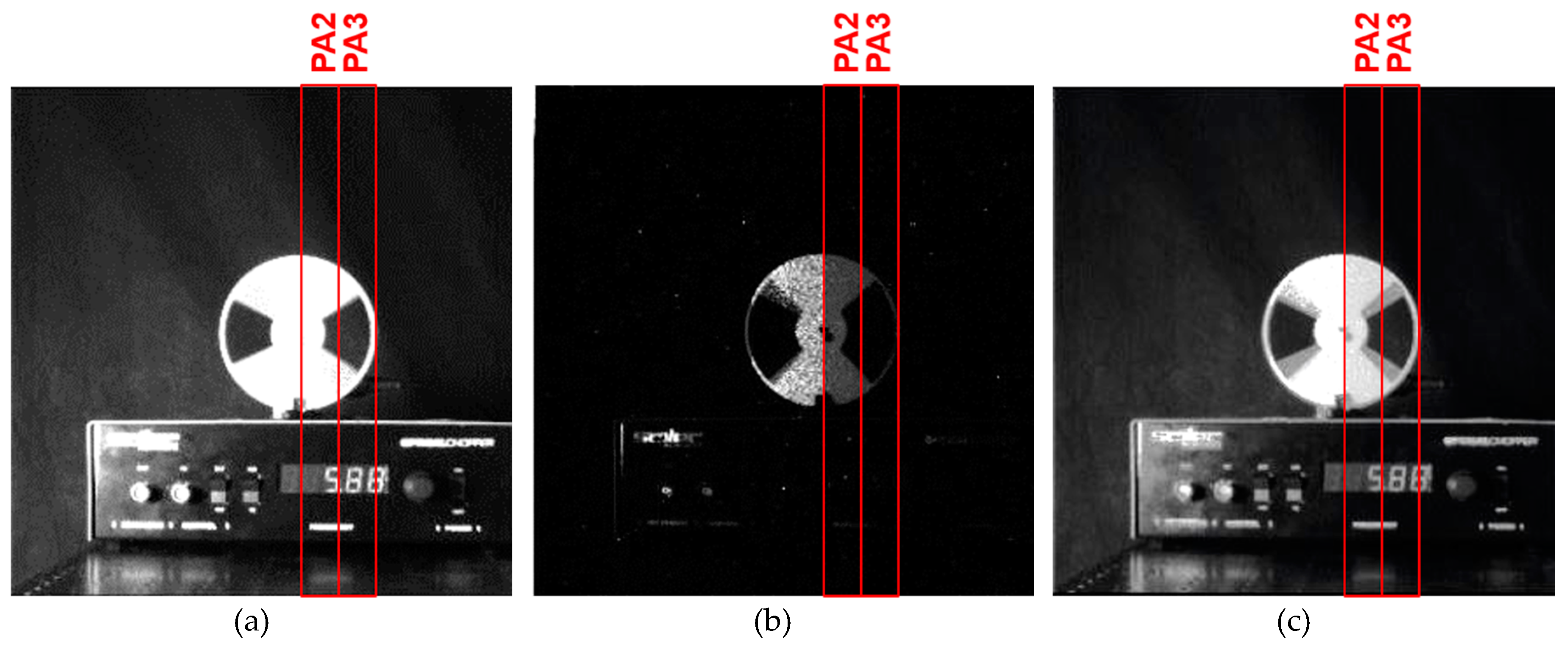
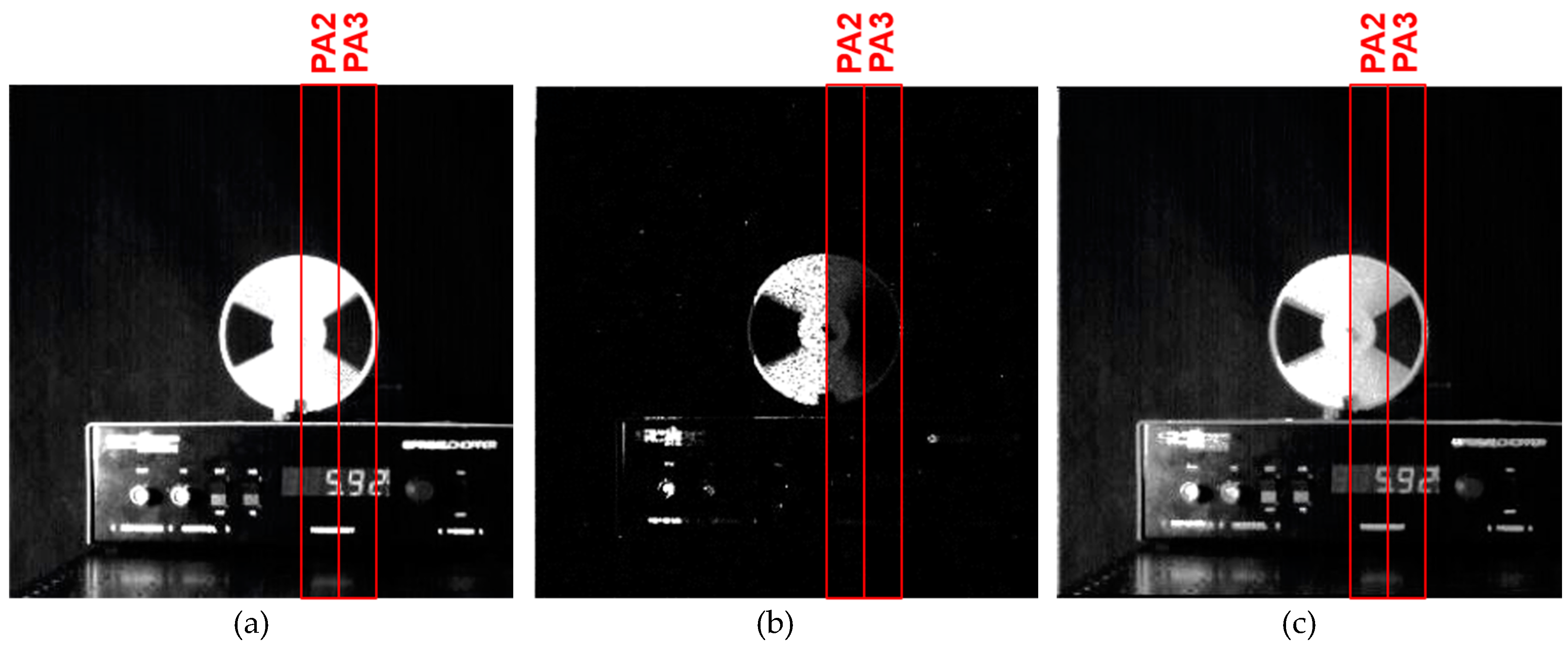
| Process | 0.11-µm CIS with pinned photodiode option |
| Pixel Size | 7.1 µm × 7.1 µm |
| Pixel Count | 280 (H) × 406 (V) |
| Fill Factor | 27.31% |
| ADC Resolution | 17 bit |
| Conversion Gain | 76.2 µV/e− |
| Sensitivity | 56 Ke−/lux·s (2850 K) |
| Noise | 3.2 e−rms (@median) |
| Frame Rate | 30.9 fps |
| Dynamic Range | 60 dB (@ SD1) 63 dB (@ SD2) 93 dB (@ RS = 30) 104 dB (@ RS = 279) |
| Multiple Sampling (Multiple Sampling at Different Timing) | LOFIC (Overflow Integration Capacitor) | This Paper (Dual Storage and Multiple Transfer) | |
|---|---|---|---|
| Dynamic Range (max.) | 112 dB @ 3.75 μm [12] 109 dB @ 20.45 μm [16] | 102 dB @ 4.2 μm [8] 130 dB @ 16 μm * [13] | 104 dB @ 7.1 μm |
| Motion Artifact | Large | Small | Small |
| Small Pixel Applicability | Very Good | Fair | Fair |
| Full Well Capacity (Shot-noise-limited SNR) | Good | Very Good | Fair (to be improved) |
| Dynamic Range Control | Flexible | Fixed | Flexible |
© 2019 by the authors. Licensee MDPI, Basel, Switzerland. This article is an open access article distributed under the terms and conditions of the Creative Commons Attribution (CC BY) license (http://creativecommons.org/licenses/by/4.0/).
Share and Cite
Lee, M.; Seo, M.-W.; Kim, J.; Yasutomi, K.; Kagawa, K.; Shin, J.-K.; Kawahito, S. A Wide Dynamic Range CMOS Image Sensor with a Charge Splitting Gate and Two Storage Diodes. Sensors 2019, 19, 2904. https://doi.org/10.3390/s19132904
Lee M, Seo M-W, Kim J, Yasutomi K, Kagawa K, Shin J-K, Kawahito S. A Wide Dynamic Range CMOS Image Sensor with a Charge Splitting Gate and Two Storage Diodes. Sensors. 2019; 19(13):2904. https://doi.org/10.3390/s19132904
Chicago/Turabian StyleLee, Minho, Min-Woong Seo, Juyeong Kim, Keita Yasutomi, Keiichiro Kagawa, Jang-Kyoo Shin, and Shoji Kawahito. 2019. "A Wide Dynamic Range CMOS Image Sensor with a Charge Splitting Gate and Two Storage Diodes" Sensors 19, no. 13: 2904. https://doi.org/10.3390/s19132904
APA StyleLee, M., Seo, M.-W., Kim, J., Yasutomi, K., Kagawa, K., Shin, J.-K., & Kawahito, S. (2019). A Wide Dynamic Range CMOS Image Sensor with a Charge Splitting Gate and Two Storage Diodes. Sensors, 19(13), 2904. https://doi.org/10.3390/s19132904





